Guide to Jar & Canister Thread Sizes & Dimensions
A product’s packaging is just as important as the product itself. You want to ensure that whatever you are packaging has the right container and lid. Determining the ideal packaging method requires many considerations, including the container size and dimensions.
In this guide, we’ll be exploring the type of container with a larger opening, commonly identified as a jar or canister. We’ll walk you through what a jar and canister thread size and dimensions mean. This should help to understand packaging options and select the best wide-mouth packaging for your product needs.

What is a Thread Size for a Jar and Canister?
A thread size is another term for a neck finish, or the protrusion of the container that a lid or closure is fastened to. Typically, for wider-mouthed containers, the term “thread size” is used instead of “neck”, which is often used for bottles and containers that feature a narrower opening at the top.
Each thread has a two-number identification system to differentiate the size of the thread. The first two-digit number refers to the neck width or the width of the opening of the container. The second three-digit number refers to the finish of the thread, which is the seal of the container.
What is the Dimension of a Jar and Canister?
The dimension of a jar and canister refers to the size of the container itself. It measures the width, length, and area of the container so that you can determine how much product will fit in the jar. For example, when looking at mason jar sizes, what you are really measuring is mason jar dimensions, so you know how many ounces can fit into the container.
Importance of Choosing the Right Thread Size and Dimension
The thread size and dimension you choose has a major impact on the success of your product packaging. You can mix and match threads to dimensions, but they are often related.
Selecting the appropriate thread size is an essential aspect of your packaging selection, as it aligns with the product’s purpose and helps provide a smooth packaging experience for the customer. By carefully considering the product’s purpose and opting for the most suitable packaging to fulfill that purpose, you can offer your customers an optimal product experience from the start.
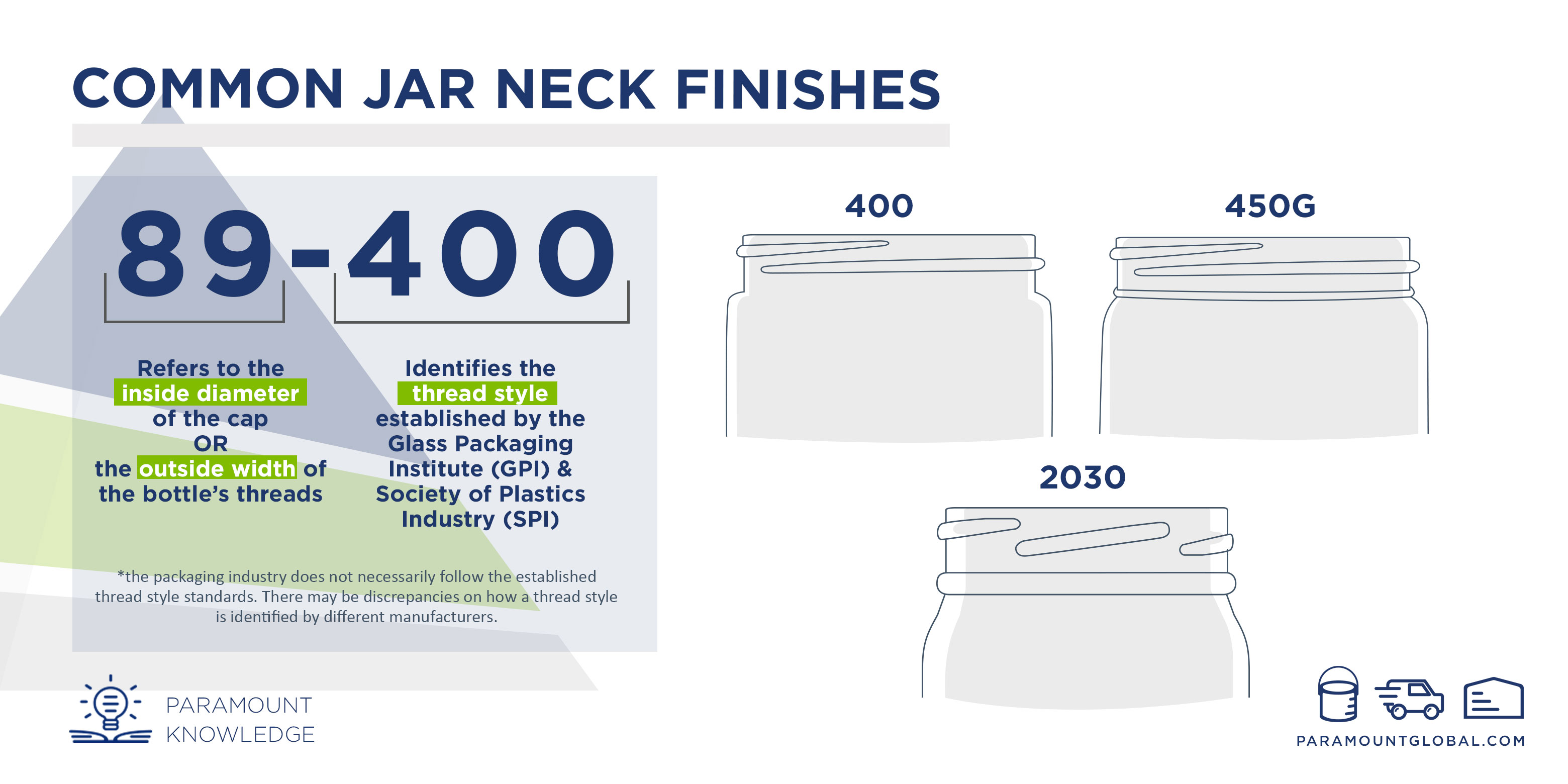
Common Canister and Jar Thread Sizes and Finishes
Here are a few of the most common canister and jar thread sizes and finishes that you will encounter when looking at different packaging options. Each variety has a different purpose and is used for various industries and types of products.
33 – 400
A thread finish found on small plastic jars ranging from ¼ oz to 1 oz sizes. These small jars are mainly used for creams and balms. Continuous thread 33-400 plastic caps are most commonly used with this thread finish.
48 – 400
Another common thread finish found on small plastic jars but accommodating slightly larger jar sizes ranging from ½ oz to 2 oz. Continuous thread 48-400 plastic caps are most commonly available for this thread finish.
53 – 400
A thread finish found on plastic and glass jars. Straight-sided jars are the most common style available in 1 oz or 2 oz sizes. Continuous thread 53-400 plastic or metal caps work best with this thread finish.
58 – 400
A thread finish found on plastic and glass jars. 4 oz straight-sided jars are the most common style with this thread finish, but a 58-400 thread finish can also be found on 8oz paragon jars. 4 oz is a common size jar for creams, lotions, and powder products. Continuous thread 58-400 plastic or metal caps work best with this thread finish.
58 – 2030
A thread finish found on glass jars such as mayo economy and hex jars. It can also be identified as 58 lug finish. The lug finish allows an air-tight seal which creates a popping noise when the seal is broken. A 58-lug metal cap works best with this thread finish and is commonly used to store food products such as salsa, preserved foods, jams, honey, and more.
63 – 2030
A thread finish found on glass jars such as paragon, sauce, universal, and hex jars. It can also be identified as 63 lug finish. The lug finish also allows an air-tight seal which creates a popping noise when the seal is broken. A 63-lug metal cap works best with this thread finish and is commonly used to store food products.
70 – 2030
The largest common lug size found on glass jars such as mayo economy and universal glass jars ranging from 12 oz to 32 oz. It can also be identified as 70 lug finish which provides the same air-tight seal as other 2030 sizes.
70 – 400
A common thread finish found on plastic and glass jars. This thread is more commonly found on plastic containers including single-wall jars, thick-wall jars, double-wall jars, straight-sided jars, and straight-sided canisters. Common sizes with this thread finish range from 2 oz to 8oz for jars and 16oz for straight-sided canisters. Continuous thread 70-400 plastic or metal caps work well with this thread finish, but plastic is the more common option.
70 – 450G
A thread finish only found on glass jars, most commonly on mason economy mayo jars ranging from 8oz to 32oz. This thread and jar type works well for food products. Continuous thread 70-450G metal caps work best with this thread finish.
89 – 400
The most versatile thread finish for wide-mouth containers. 89-400 thread finish is found on glass and plastic jars and canisters. More commonly found on plastic containers, the 89-400 thread is used across a variety of sizes ranging from 4 oz to 32 oz. For the lower range of sizes, jars with an 89-400 thread include shapes such as straight-sided jars, square pinch grip jars, single wall jars, double wall jars, and thick wall jars which are options used for creams, lotions, gels, powders, and more. For larger sizes, options are canisters which are often used for powders. Continuous thread 89-400 plastic caps are the most used to pair with an 89-400 thread container.
110 – 400
A common thread finish for larger wide-mouth plastic and glass containers. 110-400 thread finish is found on wide-mouth jars and straight-sided canisters. This thread finish accommodates larger-size containers ranging from 64 oz to 1 gallon. Plastic containers with this neck finish include wide mouth jars, square pinch grip jars, and straight-sided canisters while glass can only be commonly found in the wide mouth shape. Continuous thread 110-400 plastic caps work best with this thread finish and can accommodate accessories such as a scoop to help end users measure and retrieve accurate product quantities.
120 – 400
A common thread finish for larger straight-sided canisters. 120-400 thread is found mainly on canister sizes ranging from 32 oz to 120 oz. These larger canisters are commonly used for powder products which may include a scoop accessory for the end user to accurately measure and use the product. Continuous thread 120-400 plastic caps are the most common option to match this thread finish.
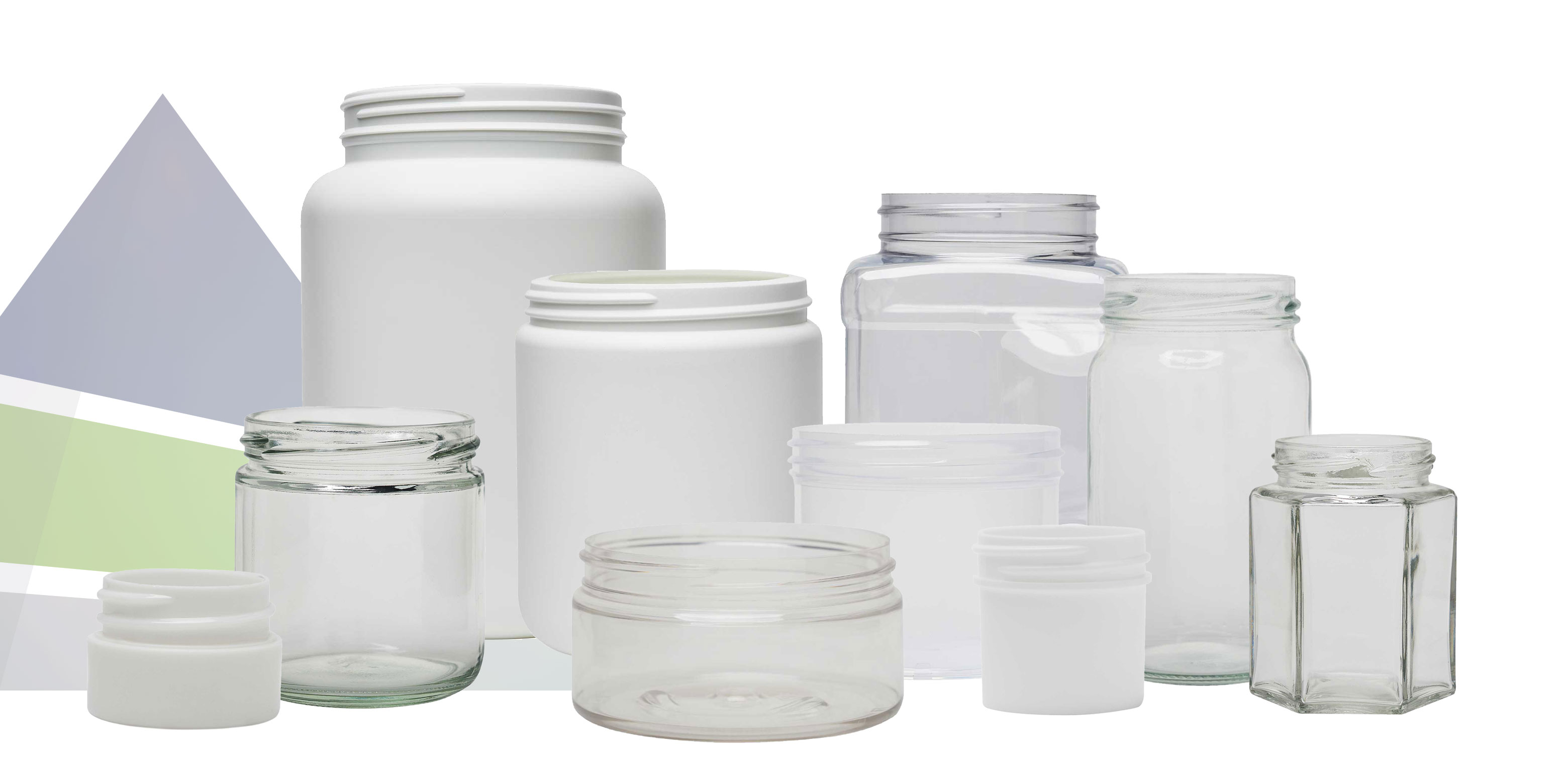
Common Canister and Jar Dimensions
It’s also important to consider the common canister and jar dimensions when you look at packaging your products. This will determine how much product fits into each container. Some of the most common dimensions include:
- 2 oz.
- 4 oz. or quarter-pint
- 8 oz. or half-pint
- 12 oz. or three-quarter pint
- 16 oz. or pint
- 24 oz. or pint and a half
- 32 oz. or quart
- 64 oz. or half-gallon
- 128 oz. or gallon
Closure Types for Canisters and Jars
While we often think of typical screw-style lids as the closure device for canisters and jars, there are some other options and variations that you might want to consider. Here is a helpful list of the different closure types that can be used for different jar and canister sizes.
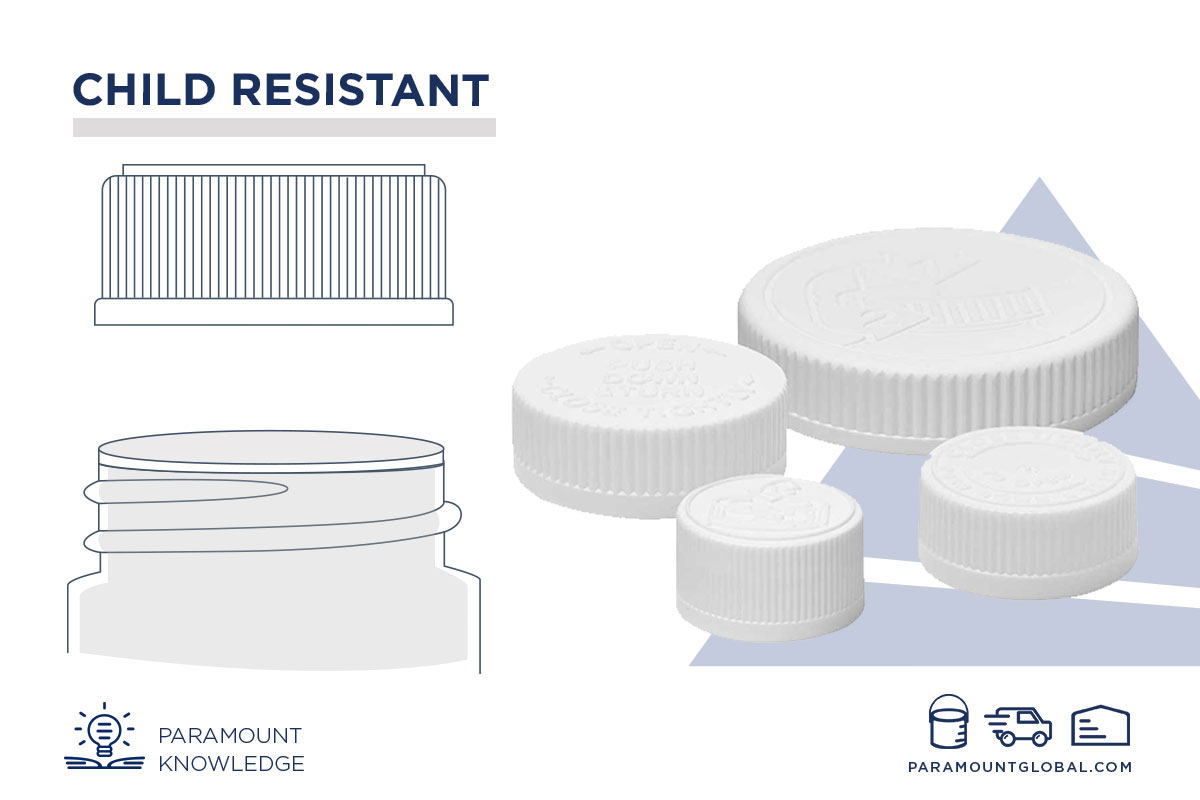
Child Resistant
Child-resistant closures are great for pharmaceuticals and other sensitive materials like chemicals. These lids have a locking mechanism that requires pressure in order to open, which makes it difficult for children to open or ingest the contents.
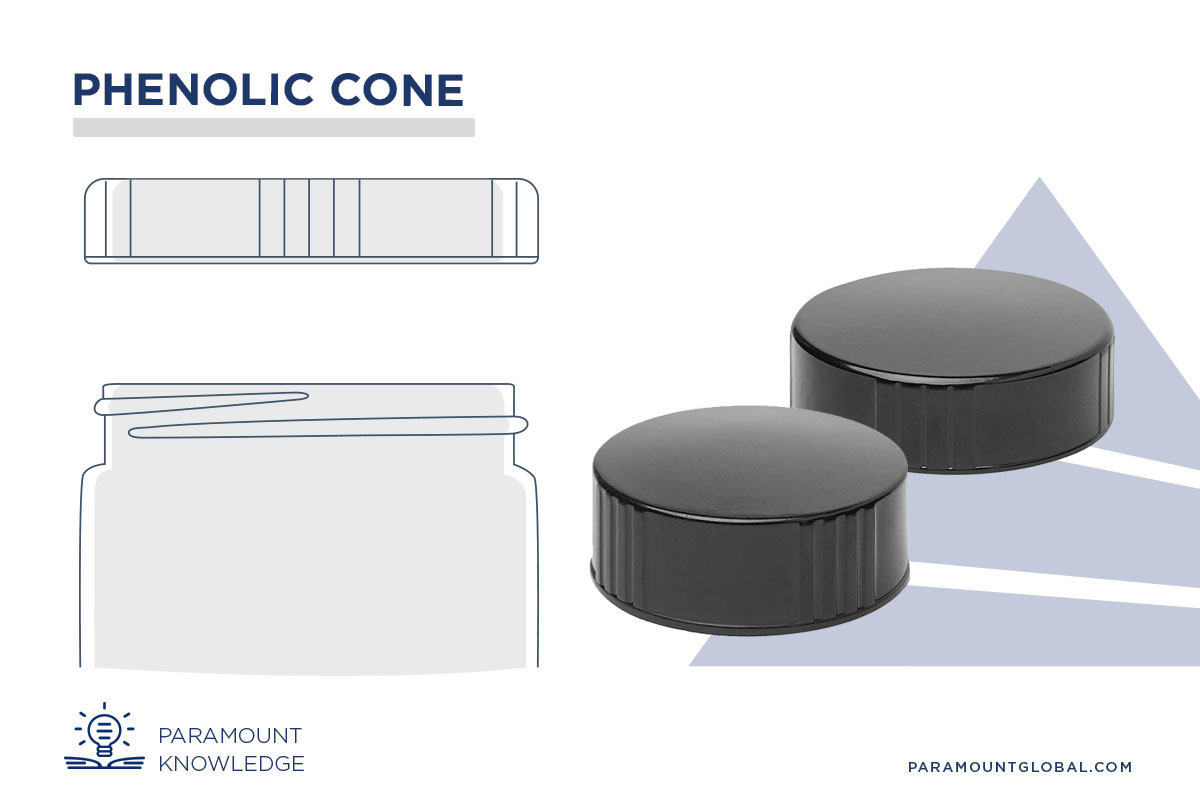
Phenolic with Cone
A phenolic with cone closure is commonly used with chemicals, solvents, and alcohols. This type of closure has a thread that spirals uninterrupted on the cap wall with a natural cone in the middle. They are a special type of continuous thread, but the cone provides additional protection for liquids inside, such as chemicals or oils.
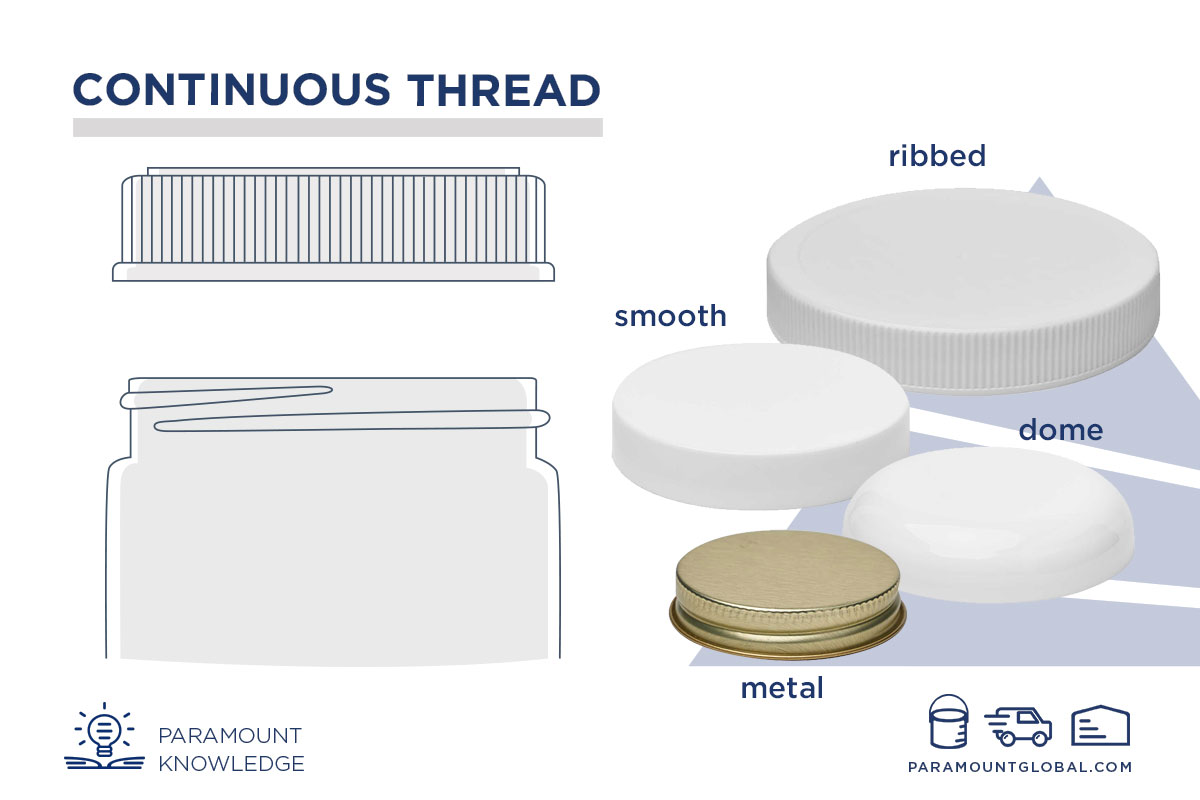
Continuous Thread
The continuous thread is the most common type of closure. It has a thread that spirals up the side of the cap and can be made of metal or other materials like plastic. They work well for paints, personal care products, pet care products, beverages, food products, and liquids. The metal lid is what we often associate with a mason jar thread size, which can be used for purposes like canning and food storage.
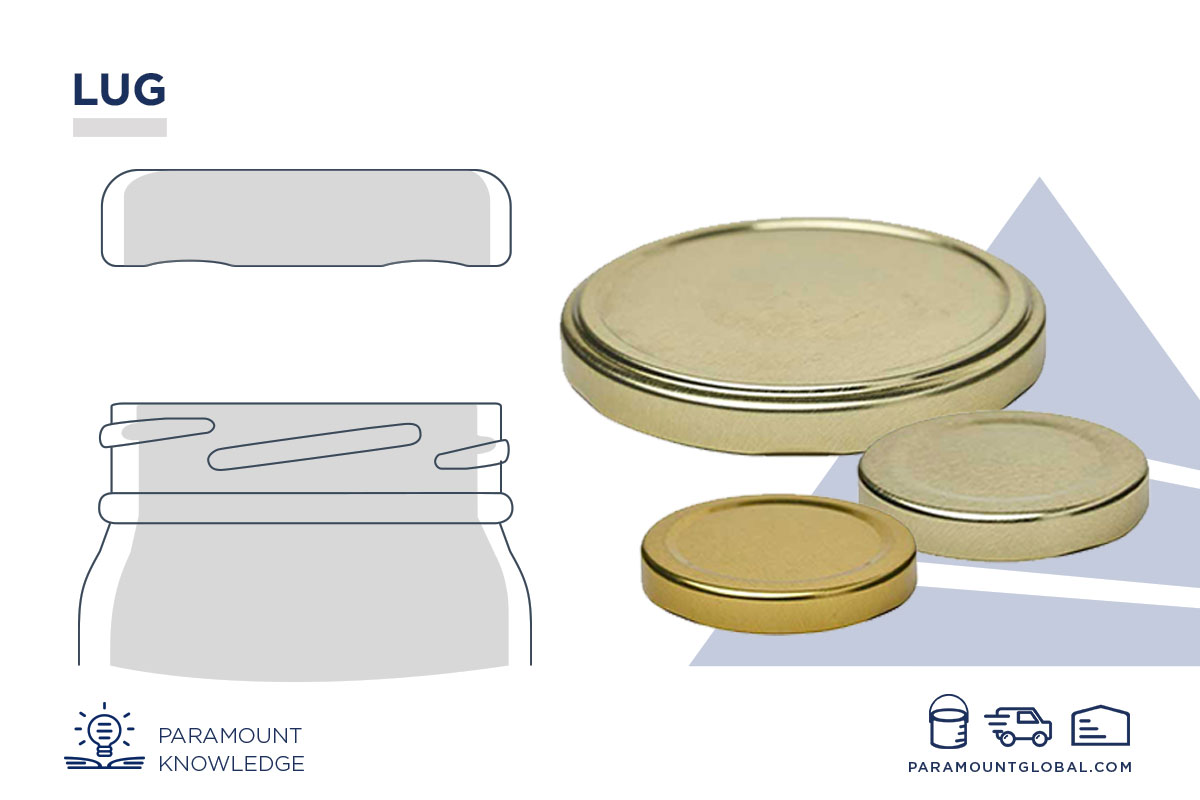
Lug
Lug caps can be identified by the distinct popping sound they make when first opened. Unlike continuous thread caps, lug caps have equally spaced threads that are not continuous. These caps are made of metal and are only suitable for use with glass jars that have a lug neck finish. They often incorporate silicone seals. Lug caps are a favored choice for products that require an airtight seal, such as salsas, jams, and other food items.
Pumps
Although less common with wide-mouth containers, a pump is an option available to keep a product sealed while offering an opening for the product to be distributed in a pump. They can be adjusted to account for the viscosity of the material in the container. They work best for personal care products, such as lotion.
Accessories
Scoops are an accessory that is commonly used with wide-mouth jars and canisters in the protein powder and supplement industry. They’re available in a variety of shapes and sizes.
How to Choose the Best Thread Size and Finish
Now that you have a better understanding of thread sizes and finishes, here are some helpful tips on how to choose the best options for your product packaging needs.
Consider what your industry is and what common thread sizes are used to package products.
Think about the customer using your product and what thread size and finish will be the best for their experience.
Examine competitors in similar shelf spaces to see the thread size and dimensions that they commonly use in their packaging.
Consider which options are best to buy in bulk or wholesale.
Work with packaging experts who understand the ins and outs of packaging to help you craft the perfect solution.
Work with an Expert and Choose the Best Packaging Solution Every Time
Finding the right thread size and dimension for your packing requires you to understand the many factors that go into packaging sizes. Trying to pick the best solution on your own can be overwhelming, especially when you are focused on other areas of your business. That’s why working with experts is the best way forward.
At Paramount Global, we understand the crucial role packaging plays in delivering an exceptional customer experience. That’s why we offer a multitude of solutions to ensure that you find the best packaging solution every time. To learn more, contact us today to speak with one of our friendly packaging specialists and discover how we can be a trusted partner in achieving your goals. From packaging design to logistics coordination, Paramount Global can partner with you every step of the way.
Hayley is a marketing professional and copywriter with a background in crafting content for a diverse range of industries. She has been writing about packaging and supply chain logistics for Paramount Global since 2022. She specializes in explaining complex topics in a clear and engaging way and is an advocate for sustainability in packaging and supply chain management.
Read More
For over forty years, Paramount has been delivering perfectly integrated packaging and supply chain solutions.
